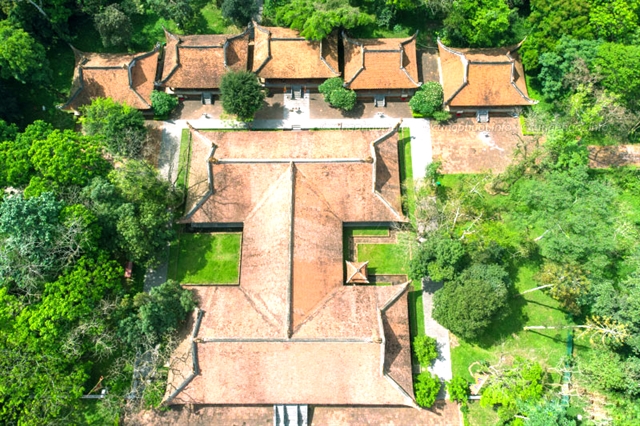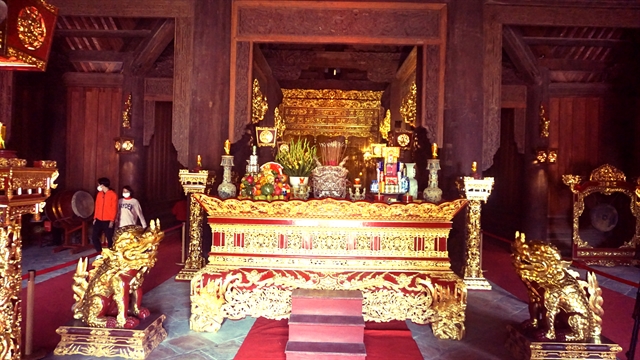Weather:
- Ha Noi 31oC
- Da Nang 26oC
- Ho Chi Minh 28oC

The special national relic site of the Lam Kinh ancient royal capital of the Later Lê Dynasty in the northern province of Thanh Hóa's Thọ Xuân District harbours mysterious tales about one of the most significant Vietnamese feudal reigns.
After more than 10 years of restoration, the site's Main Temple Hall area comprising the most important works covering over 1,600 square metres, opened at the beginning of April, attracting thousands of visitors.
The 200ha site is a complex of monuments with a large area of unique architectural works of the Later Lê Dynasty (1428-1789).
The restoration was officially completed based on the original foundations. Along with the restored works of the Main Temple Hall, other areas, including Thái Miếu (Royal Temple), Nghinh Môn (Welcome Gate), Dragon Yard or audience attending court, White Bridge, the Ngọc River and an ancient well have also been carefully preserved.
According to historical and archaeological documents, Lam Kinh Main Temple Hall was built after the death of King Lê Thái Tổ (1433), the founder of the dynasty.
It has an ironwood frame structure and was restored by artisans according to the typical model, style, shape and colour of the Lê Dynasty. The frame with six pillars is decorated with patterns of dragons on the surface of the wood.
According to a local authority official, Lam Kinh Main Temple Hall is now the largest wooden structure in Thanh Hóa, using more than 2,000 cubic metres of ironwood.
Nguyễn Trùng Khánh, general director of the National Administration of Tourism, said that Thanh Hóa's opening of the Lam Kinh heritage site for tourism was meaningful and timely as Việt Nam has just officially reopened its tourism after closure due to the pandemic.
Tourists are overwhelmed by the gold-plated worship objects and interiors when visiting the Main Hall. Tourists can also see the throne and much-gilded furniture firsthand.
Vũ Đình Sỹ, head of the management board of the Lam Kinh relic site, said that to create the magnificent work, the construction unit selected highly skilled workers.
“The interior is plated with gold in large quantities. This is not only great work but also the product of the determination and concern of the local authority and the great affection of the people of Thanh Hóa and the wider country, and a great contribution to the nation and the history of the Later Lê Dynasty,” Sỹ said.
The provincial authority officially opened the Lam Kinh relic site for tourists on April 2 and held a ceremony to celebrate on the same day.

Smart tourism project
At the ceremony, the province launched a smart tourism product project-the MobiFone Smart Travel application, to introduce tourists to many popular historical relics and scenic spots in Thanh Hóa, such as Lam Kinh in Thọ Xuân District, the Hồ Dynasty Citadel in Vĩnh Lộc District, Am Tiên in Triệu Sơn, and Pù Luông in Bá Thước.
The project will be implemented in two phases. The first will set up a smart tourism application and digitise several tourist attractions in the province.
Thanh Hóa has worked with MobiFone to digitise information on tourist draws such as the Lam Kinh relic site, the Phú Lương community tourism area, and the Hồ Dynasty Citadel, a World Cultural Heritage Site.
The second phase will develop advanced features connecting accommodation, travel agencies, restaurants, and entertainment areas.
The province also aims to develop mobile applications by 2025 to inform visitors of key tourist areas.
Land of heroes
Over nearly 600 years old, Lam Kinh relic site has preserved the ancient spiritual culture and legends of the feudal dynasty considered the most flourishing in Việt Nam's history.
Located in Xuân Lam Commune, about 50km west of Thanh Hóa City, the site is the birthplace of national hero Lê Lợi and where the famous Lam Sơn cemetery was discovered.
“Thanh Hóa is known as the 'Land of Kings and Heroes' of which Lam Kinh ancient royal capital is a significant example. I visited the site many times, and each time, I found amazing things about the relic through its historical stories," said Nguyễn Huy Mão, a tourist from Hà Nội.
"Now, although I am in my 80s, I want to visit Lam Kinh again to hear and admire more about the national heritage, particularly after the Main Temple Hall was restored."

According to Thanh Hóa provincial museum, Lam Sơn - Lam Kinh is a “sacred land and region of extraordinary people, the hometown of national hero Lê Lợi, and the starting area of the Lam Sơn Uprising which defeated the Ming Chinese invaders (1418-1427)."
On April 15, 1428, Lê Lợi took the throne in Đông Đô (Thăng Long - Hà Nội) and became King Lê Thái Tổ. He named the country Đại Việt and began the most prosperous and peaceful dynasty in Việt Nam's feudal history -- the Later Lê Dynasty lasting 360 years.
It is also the "eternal resting" place of King Lê Thái Tổ and other kings and queens of the Lê Dynasty, a symbol of national pride in the historical period in the building of the Đại Việt State.
For centuries through many ups and downs, the harshness of nature and people’s poor awareness left the site facing serious degradation and ruin.
Though the temples and shrines have been mostly gone, the surrounding landscape, architectural foundations and artefacts of the Later Lê Dynasty remain.
In 1994, the Prime Minister issued a decision to restore the Lam Kinh historical complex. Many actions were taken to preserve the original values of the site.
Experts from the Việt Nam National Museum of History conducted a series of archaeological excavations at the site, which unearthed many cultural layers and numerous relics.
These excavations also revealed the foundation and architectural structure of the complex and tens of thousands of artefacts dating from the Lê Dynasty. The artefacts provided a scientific basis to restore the site true to its origins.
The Thanh Hóa authorities have also issued policies on encouraging and attracting investment in the site and have designed tourist services and products to satisfy visitors.
Today, the site provides a confluence of heritage in Thanh Hóa, not only as a tourist attraction but also for studying the history, tradition and cultural identity of Việt Nam. VNS



